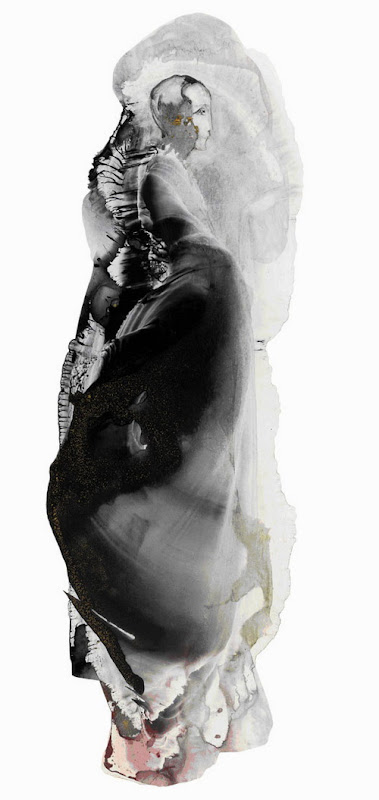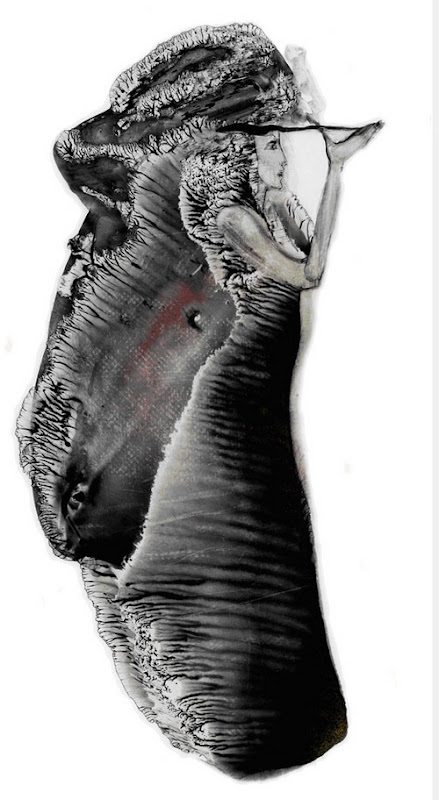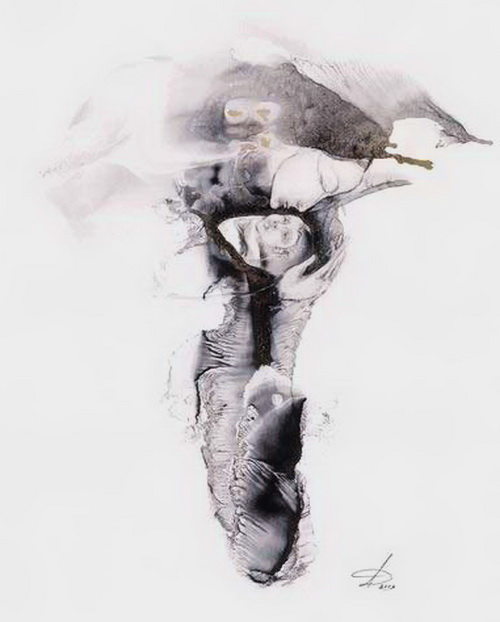Arina Daur - an artist who believes in miracles
Arina Daur is an artist, a member of the Russian Artists’ Union, Vice-Rector of the "Academia" Graphic Arts Center. She has organized international Monotype Festivals. In 2002, she was awarded the title of “Queen of Monotype” at an exhibition at the Council of Europe in Strasbourg.
The verbal overture to the monotypic image
Monotype (mono – «one», typus – «print») is one of the most amazing kinds of fine arts. That is the only image, which is obtained by printing. What for? What is the reason that motivates an artist to use this way of searching for images?
Perhaps, this is a desire to find the most direct and clear way for reading thoughts – the artist’s specific language. Any image is a monologue by which the author (who draws)appeals to the audience (whom it is intended to). During the thousands of years artists look for the way how to convey (передать смысл, звук, запах, выразить идею) the exact sound of the portrayed thought, what form and which intonation to use. Monotype makes an offing of searching for the system of graphic arts. Monotype includes the availability of the endless internal reserves. This is a specific kind of provocation, oriented to the world of fantasy.
Monotype requires for co-creation. Matisse said: "The ability to see is a creative process." Monotype is an improvisation. The artist determinates an image, he chooses the only one from a variety of options and presents it to the audience. And now the audience becomes a participant of this improvisation. You can say that the audience is required for a specific basis, which helps to take part in the improvisation. Oh, yes! But you have one. This is your visual memory with its unlimited reserves. It is your genetic memory, inherited from the ancestors. It's your tireless desire to admire with the beauty of nature. This is your developed skill of searching for beauty of form. It is your sensitive perception for the rhythms of the earth and the cosmos. This is your gratitude to the Universe.
Monotype is often called as a graphic technique. It seems better to define its position in the middle between painting and graphics. Also it can be called a graphic painting. Or it is possible to call it as a painting graphics. Due to its graphic mobility and preciosity, its sincerity and sensitivity, the monotype becomes your favorite form of representation. The artists-monotypists are the gambling people. The are glad to share their creative positive with the audience. You have ability to get acquainted with the artists-monotypists on our site.
Arina Daur





Thoughts on Silhouette
Silhouette pictures always occupied my heart. But it was Hans Christian Andersen who helped me to make the first step. The great writer was always fond of silhouette paper-cutting.
With a fabulous ease his long fingers manipulated with small scissors.
His rich imagination created miniature ballet dancers, gracious swans, tiny palaces with carved gates. In his fairy tale “Flowers for little Ida” Andersen describes his own portrait as a student fond of silhouette art.
There is much in common between a fairy tale and the art of silhouette. To such common features refer small size and refined style, in which there is nothing superfluous and condensed content and decorative nature of a detail and also a conventionally poetic space. For Andersen it was another possibility to depict a fairy tale world.
In 2005 I was preparing an exhibition devoted 200-year anniversary of Andersen. It was highly desirable for me that the presence of great writer should be felt by the exhibition visitors. I wrote several portraits of Andersen in oils, as if he himself posed for me. Batiks, porcelain dolls, sculptures and monotypes served as illustrations to the fairy tales. Many works were exhibited. But still there were empty spaces in the exhibition show. They had to be filled with something. It was then that I recollected Andersen’s passion for silhouette art. And during the night prior to opening the exhibition I cut my first series of silhouettes.
Being an artist specializing on ceramic art, I often have to deal with silhouette mentality. It is revealed in sculpture and in decorating ceramic objects. As if I heard the voice of my teacher: “Collect the form around the silhouette”. No good sculpture is possible without silhouettes. And the silhouette collects the sculpture together from different viewpoints.
I like silhouette for its maximum conventionality of the image, for the absence of color and halftones, for its accurate refinement of the color spot. A silhouette is one
of the forms the image can take.
Arina Daur
Arina Daur is an artist, a member of the Russian Artists’ Union, Vice-Rector of the "Academia" Graphic Arts Center. She has organized international Monotype Festivals. In 2002, she was awarded the title of “Queen of Monotype” at an exhibition at the Council of Europe in Strasbourg.
The verbal overture to the monotypic image
Monotype (mono – «one», typus – «print») is one of the most amazing kinds of fine arts. That is the only image, which is obtained by printing. What for? What is the reason that motivates an artist to use this way of searching for images?
Perhaps, this is a desire to find the most direct and clear way for reading thoughts – the artist’s specific language. Any image is a monologue by which the author (who draws)appeals to the audience (whom it is intended to). During the thousands of years artists look for the way how to convey (передать смысл, звук, запах, выразить идею) the exact sound of the portrayed thought, what form and which intonation to use. Monotype makes an offing of searching for the system of graphic arts. Monotype includes the availability of the endless internal reserves. This is a specific kind of provocation, oriented to the world of fantasy.
Monotype requires for co-creation. Matisse said: "The ability to see is a creative process." Monotype is an improvisation. The artist determinates an image, he chooses the only one from a variety of options and presents it to the audience. And now the audience becomes a participant of this improvisation. You can say that the audience is required for a specific basis, which helps to take part in the improvisation. Oh, yes! But you have one. This is your visual memory with its unlimited reserves. It is your genetic memory, inherited from the ancestors. It's your tireless desire to admire with the beauty of nature. This is your developed skill of searching for beauty of form. It is your sensitive perception for the rhythms of the earth and the cosmos. This is your gratitude to the Universe.
Monotype is often called as a graphic technique. It seems better to define its position in the middle between painting and graphics. Also it can be called a graphic painting. Or it is possible to call it as a painting graphics. Due to its graphic mobility and preciosity, its sincerity and sensitivity, the monotype becomes your favorite form of representation. The artists-monotypists are the gambling people. The are glad to share their creative positive with the audience. You have ability to get acquainted with the artists-monotypists on our site.
Arina Daur





Thoughts on Silhouette
Silhouette pictures always occupied my heart. But it was Hans Christian Andersen who helped me to make the first step. The great writer was always fond of silhouette paper-cutting.
With a fabulous ease his long fingers manipulated with small scissors.
His rich imagination created miniature ballet dancers, gracious swans, tiny palaces with carved gates. In his fairy tale “Flowers for little Ida” Andersen describes his own portrait as a student fond of silhouette art.
There is much in common between a fairy tale and the art of silhouette. To such common features refer small size and refined style, in which there is nothing superfluous and condensed content and decorative nature of a detail and also a conventionally poetic space. For Andersen it was another possibility to depict a fairy tale world.
In 2005 I was preparing an exhibition devoted 200-year anniversary of Andersen. It was highly desirable for me that the presence of great writer should be felt by the exhibition visitors. I wrote several portraits of Andersen in oils, as if he himself posed for me. Batiks, porcelain dolls, sculptures and monotypes served as illustrations to the fairy tales. Many works were exhibited. But still there were empty spaces in the exhibition show. They had to be filled with something. It was then that I recollected Andersen’s passion for silhouette art. And during the night prior to opening the exhibition I cut my first series of silhouettes.
Being an artist specializing on ceramic art, I often have to deal with silhouette mentality. It is revealed in sculpture and in decorating ceramic objects. As if I heard the voice of my teacher: “Collect the form around the silhouette”. No good sculpture is possible without silhouettes. And the silhouette collects the sculpture together from different viewpoints.
I like silhouette for its maximum conventionality of the image, for the absence of color and halftones, for its accurate refinement of the color spot. A silhouette is one
of the forms the image can take.
Arina Daur










